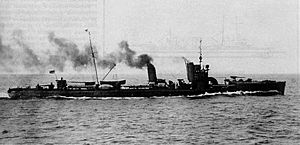SMS V4 facts for kids
Quick facts for kids History |
|
|---|---|
| Ordered | 1911 |
| Builder | AG Vulcan Stettin, Germany |
| Launched | 23 December 1911 |
| Commissioned | 15 June 1912 |
| Fate | Sunk 1 June 1916 |
| General characteristics | |
| Displacement | 697 t (686 long tons) |
| Length | 71.1 m (233 ft 3 in) oa |
| Beam | 7.6 m (24 ft 11 in) |
| Draft | 3.11 m (10 ft 2 in) |
| Propulsion |
|
| Speed | 32 knots (59.3 km/h; 36.8 mph) |
| Range | 1,190 nmi (2,200 km; 1,370 mi) at 17 knots (31 km/h; 20 mph) |
| Complement | 74 officers and sailors |
| Armament |
|
SMS V4 was a torpedo boat built for the Imperial German Navy. The letters "SMS" stand for "Seiner Majestät Schiff", which means "His Majesty's Ship" in German. V4 was part of the V1-class of torpedo boats. It was built by a company called AG Vulcan and finished in 1912. This ship served during First World War and was sunk on June 1, 1916, during the famous Battle of Jutland.
| Top - 0-9 A B C D E F G H I J K L M N O P Q R S T U V W X Y Z |
Building and Design of the Ship
In 1911, the German Navy ordered 12 new torpedo boats. Six were from AG Vulcan, and six from Germaniawerft. These new boats, including V4, were made smaller than earlier ones. The goal was to make them easier to steer and better for working with the main fleet. However, being smaller also meant they weren't as good in rough seas.
V4 was launched into the water on December 23, 1911, from Vulcan's shipyard in Stettin, Germany. It officially joined the navy on June 15, 1912.
Ship's Size and Power
The ship was about 71.1 meters (233 feet) long. It was 7.6 meters (25 feet) wide and sat 3.11 meters (10 feet) deep in the water. When fully loaded, it weighed about 697 tons.
V4 had four boilers (three used coal, one used oil) that made steam. This steam powered two turbines, which are like powerful engines. These engines gave the ship 17,000 horsepower, allowing it to reach a top speed of 32 knots (about 37 miles per hour). It could travel about 1,190 nautical miles (1,370 miles) at a speed of 17 knots.
Weapons and Crew
The ship was armed with two 8.8 cm (3.5 inch) naval guns, one at the front and one at the back. It also had four 50 cm (19.7 inch) torpedo tubes. Torpedoes are underwater weapons that can sink other ships. V4 could also carry up to 18 naval mines, which are explosives placed in the water to damage enemy ships. In 1916, the ship's guns were upgraded to more powerful 8.8 cm guns. A crew of 74 officers and sailors worked on board V4.
Service in World War I
In May 1914, V4 was part of the 10th Half-Flotilla, which was a group of torpedo boats. This group belonged to the 5th Torpedo Boat Flotilla.
Battle of Heligoland Bight (1914)
On August 28, 1914, British ships tried to ambush German torpedo boats in an area called the Heligoland Bight. The 5th Torpedo Boat Flotilla, including V4, was sent to investigate reports of British submarines. They soon ran into several British destroyers. The German flotilla tried to escape, but V4's sister ship, V1, was hit by British shells. Luckily, a German cruiser arrived and helped the 5th Flotilla get away. However, Germany lost three light cruisers and one torpedo boat in this battle.
Battle of Dogger Bank (1915)
V4 was also present at the Battle of Dogger Bank on January 24, 1915. This was another naval battle between British and German forces.
Battle of Jutland (1916) and Sinking
The most famous battle V4 took part in was the Battle of Jutland on May 31 – June 1, 1916. V4 was still with the 10th Half-Flotilla, helping the main German battle fleet.
In the early morning of June 1, as the German fleet was returning to base, a large explosion happened underwater. It was likely caused by a floating mine. The explosion blew off the front part of V4. Eighteen crew members died, and four were injured. After the survivors were rescued, V4's sister ship, V6, sank V4 completely using shellfire and a torpedo. This was done to prevent the damaged ship from falling into enemy hands.
See also
- German ocean-going torpedo boats of World War I


